In case you havent noticed, the compact fluorescent bulb-once the darling of the green energy set-is dead meat. Its soon to be displaced by cheaper, brighter and more efficient light emitting diode technology. The same has happened in automotive lighting and many new light sport aircraft have LED nav and landing lights. Legacy certified aircraft would probably have more LED technology too, if the FAA hadnt worked so hard to chill the market by raising expensive certification hoops. Nonetheless, a few hardy companies have created LED products-landing and taxi lights and nav lights-for the aftermarket. The market has actually expanded slightly since we last examined these products a year-and-a-half ago. Moreover, we expect to see more products for the certified market during the next couple of years, mirroring the emerging trend in all segments of the lighting market. For this report, we tried seven LED products, all but one being pitched as landing or taxi lights. Our impression is that companies have improved the performance of LEDs to the extent that theyre no longer just curiosities. However, they remain expensive-as much as 20 times more than an incandescent bulb intended for the same application. However, even at those prices, a LED landing light might make sense for some owners.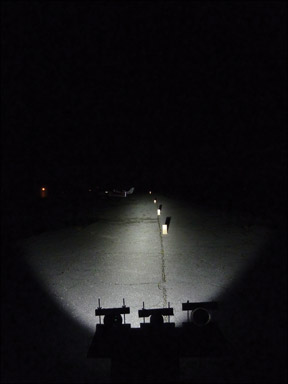
LED Tech
Recent breakthroughs in LED manufacturing have brought prices down, improved efficiency and output and also increased the range of colors the lamps can output. Unfortunately, the industry standard GE 4509 PAR 36 that the vast majority of airplanes have as landing lights is neither the most reliable nor best bulb going. (PAR refers to parabolic aluminized reflector and the 36 is actually the lamp diameter expressed in increments of 1/8 inch, thus the PAR 36 is 4.5 inches in

diameter.)
Five of the lights we tried were PAR 36 equivalents, more or less. Its more or less because although the diameters are the same as the 4509, the depth may not be, due to the LED heat sink on the back that keeps the diodes from frying. This is a sensitive point that Whelans Jeff Argersinger says must be explained and its the reason that brightness measurements alone don’t tell the full story about LEDs.
One characteristic of LEDs is that they can be driven harder to produce more light and some designs do exactly that. To keep the LEDs from burning up, a larger, more efficient-that may mean deeper-heat sink is used on the back of the lamp.
That means it may or may not fit the same mount that housed the original 4509. The selection of lamps we tested were all of varying depths and all but two were deeper than a 4509. The exceptions-Whelans 12 LED Parmetheus product, which is actually inch shallower than a 4509 and the AeroLED SunSpot. The Laminar Flow vproduct, depending on how its mounted, might also be shallower than a 4509.
In our estimation, the LED lamps in this group are likely to fit most applications, especially if the space behind the existing conventional lamps is open and unobstructed by the mount hardware.
Before buying any of these products, we would advise asking the manufacturer about what specific applications have been directly tested and, if there’s any
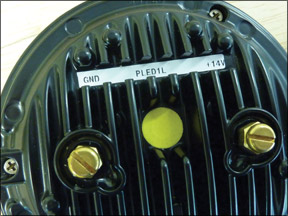
doubt that yours is among them, ask about return policies. We doubt if any companies would refuse returns on lamps that don’t fit.
Approvals
This is a sticky point for LED re- placements, although it shouldnt be. The FARs are utterly open-ended about lighting requirements for light aircraft. Heres the entire spiel from FAR 23.1383: Each taxi and landing light must be designed and installed so that: (a) No dangerous glare is visible to the pilots. (b) The pilot is not seriously affected by halation. (c) It provides enough light for night operations. (d) It does not cause a fire hazard in any configuration. (Halation is the undesirable spreading of the light beam.)
Seems simple enough, but all the LED manufacturers told us that various regional FAA Aircraft Certification Offices have nonetheless dreamed up additional testing requirements and at least one has both refused to provide an approval path while also declining to provide suggestions for a test program that would yield such a path.
Moreover, landing light bulbs are not TSOd-although strobes are-and its not
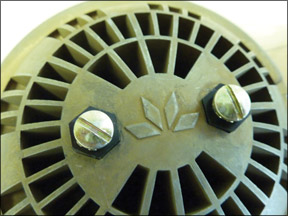
clear that a PMA of any kind is required to replace a bulb. Whelan is, nonetheless, planning an STC approval process for its Parmetheus bulb.
AeroLED told us some of its products have been installed under Form 337 approval but also noted that some FSDOs have refused to approve this. For its Alphabeam, Teledyne is pursuing a PMA, even though the 4509 it replaces doesnt have one.
Frankly, since there’s no clear guidance prohibiting it, we would be inclined to simply install the bulb as though it were a 4509 and let the cards fall where they may. Heres a summary of the products we examined.
Teledyne Alphabeam
Teledynes Light and Display Products specializes in advanced LED lighting systems for various industries. It got into the landing light game the same way other companies have launched aviation products-someone on staff was a pilot and saw an opportunity.
Teledyne engineer George Panagotacos is a pilot and operator of an aircraft maintenance shop with his brother and saw a way to leverage the companys expertise in LEDs into the aviation business. The divisions launch product is the Alphabeam, a highly engineered direct, drop-in replacement for the GE 4509.
Panagotacos told us that the Alphabeams light pattern is almost identical to the 4509 but more symmetrical and slightly broader. We see this as a good thing, because at 6 degrees of width horizontally, the 4509 is considered somewhat over- focused-its like looking at the dark world through a toilet paper tube. The Alphabeam-and other LEDs-address that, at the slight expense of not having the distance punch.
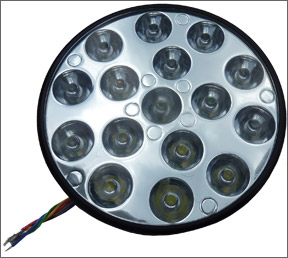
A principle challenge in designing effective LED landing lights is focusing the light output and balancing beam width against distance focus. The Alphabeam does this through technology called total internal reflection, or TIR. This method surrounds each LED emitter with a sophisticated reflector system that aims emissions from four-LED groups into a cogent whole.
Temperature control is also a critical issue with LEDs and relates directly to light output. The Alphabeam has a robust heat sink, making it inch deeper than a typical 4509. (4509s actually vary a little, depending on manufacturer.) The device has a peak draw of 45 watts at any voltage between about 10 and 40, but typically runs at about 35 watts.
As its temperature rises, the bulbs thermal protection circuitry folds the power output back to protect the LED junctions, although its unclear if this make a visible difference in light output. Teledyne says the projected lifetime of the lamp is a minimum of 5000 hours. (During our tests, the Alphabeams heat sink got too hot to handle, as did most of the lamps.)
Its non-polarized, so you cant fry it by incorrect polarity. Retail price of the Alphabeam through Aircraft Spruce is $325 and it should be available later this year.
Whelan Parmetheus
Whelan has been in the aircraft lighting game since 1952 and its rotating beacons are all but the industry standard. Whelan has a rapidly expanding line of LED products and not just in aviation.
It has its own version of TIR in a new product called the Parmetheus which, like the Alphabeam, is intended as a direct 4509 replacement. Its available in both landing light version with a 10-degree beam and a spreader taxi version with a 40-degree beam.
Whats most noticeable about this lamp is its size-its only 1.75 inches deep, so its more compact than the 4509 it replaces. That means it ought to fit any mount, with no interference. Whelan projects a 10,000-hour operating life for the Parmetheus and it carries a three-year warranty, meaning its essentially a lifetime bulb. Its available from Spruce in 14- or 28-volt versions for $239 to $268.
AeroLEDs
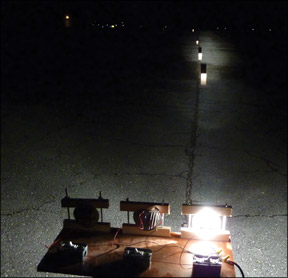
When we last examined LEDs, we complained about an over wide beam width that spread the light too much to make out distant detail. So AeroLEDs sent us a new product, with a narrower beam and it reports it will soon introduce new products that are brighter still.
The product we tried-the 16-LED SunSpot-is intended as a combination landing/taxi/recognition light, which qualifies it as the most feature packed of all the products. (At $469.50 from Spruce, it ought to be.)
Where the other lamps have two or three leads, the SunSpot sports five. It can be configured as a landing light, a single flashing recognition light or, if used with another SunSpot, a wig-wag setup. At 1.25 inches deep, its the shallowest of the lamps we tried and ought to fit about any mount.
Other Options
Of the three other products we tried, only one is intended as a 4509 replacement. Thats the 12-LED lamp from Laminar Flow Systems. We don’t have a price on this yet, but it also includes a flashing function and, uniquely, a cooling fan to force air through the heat sink.
Also from Spruce is a $529 product called the Electronic Landing Light, a German-made unit intended for the experimental or LSA market. At 3 inches in diameter, its too small for the 4509 mount but might be useful elsewhere. It has a blinding, attention-getting red flasher that will leave you seeing spots.
Last, we took a look at a new LED wingtip taxi light package from Malibu Aerospace. This is a developmental product intended solely for Pipers PA-46 line. Its priced at about $1700.
Field Trials
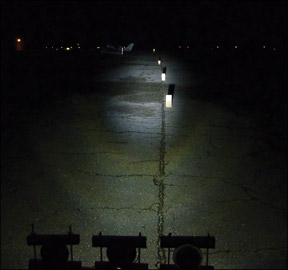
The graphic on page 13 shows how we set up our test range. While brightness is not the final arbiter of LED effectiveness, its not irrelevant, either. And bluntly, measured against a Q4509, the LEDs hardly hold a candle , so to speak. But the 4509s brighter beam is also hot yellow and narrowly focused, so it misses illuminating things youd want to see-perhaps a deer darting across the runway or the protruding tail of an airplane.
LEDs are typically in the 6500 Kelvin range-much bluer-than the 2500 Kelvin of incandescent bulbs. This produces an effect closer to daylight and although objects may not stand out more, theyre easier to resolve, in our view. Viewed from the business end, they stand out better in sunlight as a recognition light and especially conspicuous when flashing.
Moreover, the 4509s sharp-edged spotlight misses things outside its illumination cone, making it a terrible taxi light. All the LEDs we tried had a broader beam and illuminated things the 4509 missed at a slight expense of distance illumination.
Ranked in brightness, the Laminar Flow led the group, with the Whelan Products and AeroLEDs in the middle and the Alphabeam and Electronic Landing Light trailing. But perceived brightness, well, thats a different story. You can see a barely noticeable difference between the brightest and dimmest bulbs, but we cant honestly say its much of a distinction. The diminutive Electronic Landing Light appears hobbled by its small size and, in any case, its suitable only for experimental aircraft.
Conclusion
We like these products and even though theyre expensive, we think they deliver value through their longevity, flexible beam width and favorable color temperature. Because theyre so much more expensive than conventional incandescents, we think the right way to look at them is as always-on recognition systems that double as landing lights, not the reverse. Even if you fly only in daylight, these products deliver benefits. If you fly under 50 hours a year, justifying the expense might be a reach.
Our top price-is-no-object pick is the AeroLED SunSpot, since its bright and includes a flasher. If were going to have LEDs, we want the flasher option. The Laminar Flow is a good pick, too, but it isn’t in production yet. The best value option without a flasher? Hands down, its Whelans Parmetheus. Its a good performer at a reasonable price and its small size means it will fit any mount.


